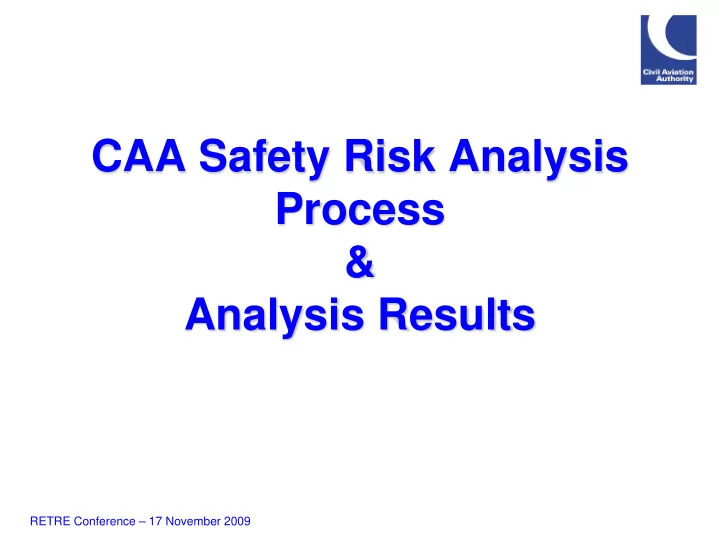

CAA Safety Risk Analysis Process & Analysis Results RETRE Conference – 17 November 2009
Content Background CAA Safety Risk Analysis Process Analysis Results Questions RETRE Conference – 17 November 2009
Background Safety Performance Indicator (SPI) 2 ‘Partnership in Safety’ Conference 2009 SPI 2 WG UK Commercial Air Transport Aeroplane High-Severity Occurrence Rate Task Forces 60 Rate (per million flights) 50 40 35.8 Actual Rate 30 Monitoring Line 30.3 20 10 0 Mar05 Jun05 Sep05 Dec05 Mar06 Jun06 Sep06 Dec06 Mar07 Jun07 Sep07 Dec07 Mar08 Jun08 Sep08 Dec08 Mar09 Jun09 Sep09 12-Months Ending: RETRE Conference – 17 November 2009
CAA Safety Risk Analysis Process AAG Identification of Main Risks Worldwide Post crash fire Loss of control Controlled flight into terrain Runway excursions RETRE Conference – 17 November 2009
CAA Safety Risk Analysis Process AAG Identification of Main Risks Worldwide Identification of Additional Risks in the THREAT UK Environment Airborne conflict Ground conflict (including runway incursions) Ramp incidents RETRE Conference – 17 November 2009
CAA Safety Risk Analysis Process Airborne Conflict Airborne Conflict AAG Identification of Main Risks Worldwide Runway Overrun Runway Overrun Loss of Control Loss of Control or Excursion or Excursion Identification of Additional Risks in the THREAT UK Environment Controlled Flight Controlled Flight Airborne & Post Airborne & Post Task Forces Task Forces into Terrain into Terrain Crash Fire Crash Fire Further Analysis and CAA Task Forces Development of Mitigations Ramp Incidents Ramp Incidents Ground Collision & Ground Collision & Runway Incursion Runway Incursion RETRE Conference – 17 November 2009
CAA Safety Risk Analysis Process AAG Identification of Main Risks Worldwide Identification of Additional Risks in the THREAT UK Environment Further Analysis and Identification of Precursors CAA Task Forces Development of Mitigations of Main Risks Prioritisation of Safety Risks and Definition of CAA Safety Plan RETRE Conference – 17 November 2009
THREAT Dataset Grade A or B MORs G-registered or UK operated (AOC): Jet and turboprop aeroplanes > 5,700 kg Turbine helicopters > 3,175 kg Passenger and cargo operations only Occurring worldwide since 1 Jan 2005 RETRE Conference – 17 November 2009
Analysis Overview THREAT analysed: 112 high-severity occurrences in 2005-08 1 fatal accident 12 other accidents, 37 serious incidents, 62 occurrences 2 grade A occurrences 18 occurrences involving aircraft damage 10 occurrences involving injuries RETRE Conference – 17 November 2009
Overall Trend RETRE Conference – 17 November 2009
Location and Phase of Flight Location: Half in UK, half abroad Foreign included: Spain (11), USA (9), France (6) and Germany (5) Phase of flight: Approach and landing (34) Take-off and climb (28) Cruise (18) RETRE Conference – 17 November 2009
Aircraft Class Aircraft Class Number Aeroplane 103 Helicopter 9 12-Month Moving Average Rate by Aircraft Class 35.0 High-Severity Occurrence Rate (per Aeroplane Aircraft Class Rate (per 30.0 Helicopter million 25.0 flights) million flights) Aeroplane 21.3 20.0 15.0 Helicopter 13.0 10.0 5.0 0.0 Dec05 Mar06 Jun06 Sep06 Dec06 Mar07 Jun07 Sep07 Dec07 Mar08 Jun08 Sep08 Dec08 12-Months Ending: RETRE Conference – 17 November 2009
Propulsion Type Propulsion Number Type Jet 82 12-Month Moving Average Rate by Propulsion Type Turboprop/ 30 40.0 High-Severity Occurrence Rate (per Helicopter Jet 35.0 Turboprop/Helicopter Propulsion Rate (per 30.0 million flights) Type million 25.0 flights) 20.0 Jet 19.9 15.0 Turboprop/ 21.3 10.0 Helicopter 5.0 0.0 Dec05 Mar06 Jun06 Sep06 Dec06 Mar07 Jun07 Sep07 Dec07 Mar08 Jun08 Sep08 Dec08 12-Months Ending: RETRE Conference – 17 November 2009
Nature of Flight Nature of Number Flight Passenger 109 Cargo 3 Nature of Rate (per Flight million flights) Passenger 20.2 Cargo 20.8 RETRE Conference – 17 November 2009
Event Groups RETRE Conference – 17 November 2009
Event Types Event Group Top-Ten Event Types (not mutually exclusive) Airborne Conflict Airprox 27 Damage to Aircraft Damage to aircraft 18 Hard Warnings TCAS RA 12 Aircraft Technical Malfunction/Failure Instrumentation (including all flight deck displays) 9 Medical Injury (non-fatal) 9 Aircraft Technical Malfunction/Failure Engine (including loss of power for any reason) 7 Loss of Control On ground 6 Abnormal Runway Contact Hard landing 5 Airborne Conflict Loss of separation 5 Hard Warnings Stall warning/stickshake 5 Runway Excursions/Overruns Runway excursions/overruns 5 Terrain Conflict Flight below safety altitudes/decision heights 5 Turbulence Encounter Wake turbulence 5 RETRE Conference – 17 November 2009
Causal Factor Groups RETRE Conference – 17 November 2009
Causal Factors Causal Factor Group Top-Ten Causal Factors (not mutually exclusive) Crew Omission of action/inappropriate action 20 Crew Failure in CRM 19 Other Caused by other aircraft/vehicle 18 Crew Poor professional judgement/airmanship 18 Crew Flight handling 17 Aircraft Design Design shortcomings 17 ATC/Ground Aids Incorrect or inadequate instruction/advice 15 Infrastructure Incorrect, inadequate or misleading information to crew 13 Crew Lack of awareness of circumstances in flight 12 ATC/Ground Aids Failure to provide separation – airborne 12 RETRE Conference – 17 November 2009
Potential Catastrophic Outcomes RETRE Conference – 17 November 2009
Positive Factors Some form of providence was present in 21 (or 19%) of all occurrences RETRE Conference – 17 November 2009
THREAT Observations Lack of in-depth understanding by pilots of how aircraft operate beyond their interface with the technology Operators could make better use of FDM to identify and correct non-standard operating technique, which if uncorrected could lead to an accident Importance of pilots understanding the level of protection afforded by ATS provision in different types of airspace and knowing when heightened lookout is required RETRE Conference – 17 November 2009
THREAT Observations It has been identified that some operator’s Operations Manuals do not reflect the Aircraft Flight Manual nor the manufacturer’s recommended procedures Need for the CAA to better share lessons learnt, through the investigation of safety data, with the aviation community in general RETRE Conference – 17 November 2009
Summary Increasing trend in overall number and rate of high-severity occurrences Wide variety of events and causes Providence features strongly Relatively low number involving helicopters and cargo operations – are we seeing the true picture? RETRE Conference – 17 November 2009
Thanks For Your Attention Any Questions? RETRE Conference – 17 November 2009
Recommend
More recommend